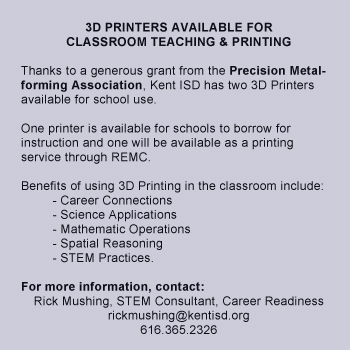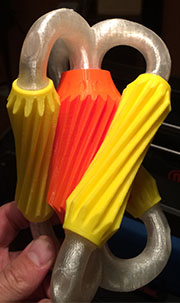Video game fan Izaak Smith’s sword hilt, outfitted with a wooden blade, was in his hand for the Grand Rapids Comi-Con convention.
But the Comstock Park High School sophomore didn’t buy the handle at a store or order it online. He created a design using 3D software and printed his piece, fashioned in the style popular Minecraft characters use, at school.
Using a 3D printer, technically called a Makerbot Replicator 2, in math teacher Dave Staublin’s class, Izaak has learned to create complex designs using the SketchUp 3D drawing program. He has also created a Minecraft figurine.
“Last year I heard a rumor that the school had a 3D printer, and I started thinking in the summer what I would make,” said Smith, who hopes to become an engineer. “This is really cool and I’m so glad I was able to do it.”
Meanwhile, at Kent City High School, senior Kendra Coalter said her school’s technology class has already helped her make some career choices.
The 17-year-old said she wants to study graphic design in college and is already taking classes in the field through the Kent Career Technical Center. Conceding her chosen field requires more of a two-dimensional view, Coalter said the Kent City technology class built around a 3-D printer has helped broaden the way she sees her designs.

“You can draw things and make them into your own 3-D objects,” Kendra said. “It’s helped me have a broader perspective of my career choices. Three-D printing is going to be a lot more common in the future. If you lose something, you could probably make your own copy.”
Teacher Kelly Hartley said other students have had similar reactions to the class that combines a bit of geek chic with academic rigor. Students must learn and master a series of computer programs allowing them to enter drawings and design parameters into a 3-D printer that creates three-dimensional objects consistent with their designs.
“We are able to use readily available software to create things in 3-D,” Hartley said. “Once students create an object in the program, the software automatically calculates support materials.”
Comstock Park Teacher Dave Staublin received a $5,000 STEM (Science, Technology, Engineering and Math) grant from the Comstock Park Education Foundation for two 3D printers. The printers use a process called stereolithography. Plastic line is heated up in the printer and is squeezed out into a little strand that creates the programmed design in layers of plastic. The finished items are strong and durable.
“My objective is to help students with spatial analysis,” Staublin said. “I’m also trying to foster creativity and turn kids on to potential careers in engineering and technology.
Staublin showed a hyperbolic planetary gear set, created with the printer, complete with angles and rotating parts. The space-agey named piece is used in engines for construction equipment and automobiles. He and students have also printed chains, toys, and spinning tops.
The real-life applications of advanced 3D printing are spreading across many industries including automotive, aerospace and medicine.
“Manufacturing isheaded in this direction and any kid interested in that field might be interested in this class,” Kent City Teacher Kelly Hartley said. “Instead of prototyping, manufacturers will create products in this material to make sure things work and fit together.”
Students start with a complex drawing, based perhaps on a photo or other objects provided for learning purposes in a number of catalogues online. Students then enter object parameters into a computer program that automatically creates any support structures needed to keep it together until the object solidifies.
After the designs are entered, the machine first lays down an adhesive substance to help the primary building material stick to a platform so a given object doesn’t move as the objected is slowly created.

The extruder then moves around the platform, leaving a trail of plastic in the specified shapes that can be as simple as a plaque with a few raised surfaces to near perfect replicas of Celtic knots.
The support structures eventually are removed. Hartley said the process requires and helps students sharpen their problem-solving skills.
Mind-boggling uses include printing organs using a patient’s own cells, and food.
CONNECT








